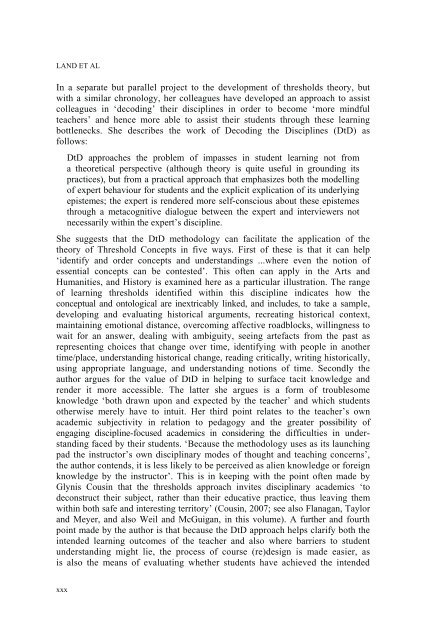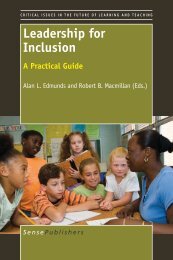1177-threshold-concepts-and-transformational-learning
1177-threshold-concepts-and-transformational-learning
1177-threshold-concepts-and-transformational-learning
- No tags were found...
You also want an ePaper? Increase the reach of your titles
YUMPU automatically turns print PDFs into web optimized ePapers that Google loves.
LAND ET ALIn a separate but parallel project to the development of <strong>threshold</strong>s theory, butwith a similar chronology, her colleagues have developed an approach to assistcolleagues in ‘decoding’ their disciplines in order to become ‘more mindfulteachers’ <strong>and</strong> hence more able to assist their students through these <strong>learning</strong>bottlenecks. She describes the work of Decoding the Disciplines (DtD) asfollows:DtD approaches the problem of impasses in student <strong>learning</strong> not froma theoretical perspective (although theory is quite useful in grounding itspractices), but from a practical approach that emphasizes both the modellingof expert behaviour for students <strong>and</strong> the explicit explication of its underlyingepistemes; the expert is rendered more self-conscious about these epistemesthrough a metacognitive dialogue between the expert <strong>and</strong> interviewers notnecessarily within the expert’s discipline.She suggests that the DtD methodology can facilitate the application of thetheory of Threshold Concepts in five ways. First of these is that it can help‘identify <strong>and</strong> order <strong>concepts</strong> <strong>and</strong> underst<strong>and</strong>ings ...where even the notion ofessential <strong>concepts</strong> can be contested’. This often can apply in the Arts <strong>and</strong>Humanities, <strong>and</strong> History is examined here as a particular illustration. The rangeof <strong>learning</strong> <strong>threshold</strong>s identified within this discipline indicates how theconceptual <strong>and</strong> ontological are inextricably linked, <strong>and</strong> includes, to take a sample,developing <strong>and</strong> evaluating historical arguments, recreating historical context,maintaining emotional distance, overcoming affective roadblocks, willingness towait for an answer, dealing with ambiguity, seeing artefacts from the past asrepresenting choices that change over time, identifying with people in anothertime/place, underst<strong>and</strong>ing historical change, reading critically, writing historically,using appropriate language, <strong>and</strong> underst<strong>and</strong>ing notions of time. Secondly theauthor argues for the value of DtD in helping to surface tacit knowledge <strong>and</strong>render it more accessible. The latter she argues is a form of troublesomeknowledge ‘both drawn upon <strong>and</strong> expected by the teacher’ <strong>and</strong> which studentsotherwise merely have to intuit. Her third point relates to the teacher’s ownacademic subjectivity in relation to pedagogy <strong>and</strong> the greater possibility ofengaging discipline-focused academics in considering the difficulties in underst<strong>and</strong>ingfaced by their students. ‘Because the methodology uses as its launchingpad the instructor’s own disciplinary modes of thought <strong>and</strong> teaching concerns’,the author contends, it is less likely to be perceived as alien knowledge or foreignknowledge by the instructor’. This is in keeping with the point often made byGlynis Cousin that the <strong>threshold</strong>s approach invites disciplinary academics ‘todeconstruct their subject, rather than their educative practice, thus leaving themwithin both safe <strong>and</strong> interesting territory’ (Cousin, 2007; see also Flanagan, Taylor<strong>and</strong> Meyer, <strong>and</strong> also Weil <strong>and</strong> McGuigan, in this volume). A further <strong>and</strong> fourthpoint made by the author is that because the DtD approach helps clarify both theintended <strong>learning</strong> outcomes of the teacher <strong>and</strong> also where barriers to studentunderst<strong>and</strong>ing might lie, the process of course (re)design is made easier, asis also the means of evaluating whether students have achieved the intendedxxx




